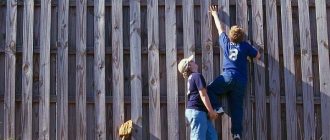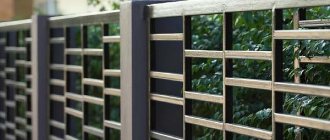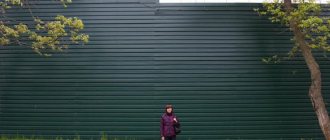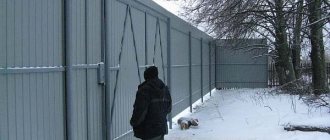There are legal and regulatory acts designed to regulate the situation, which land owners characterize as “a neighbor’s fence on my property.” Many people are interested in what to do if a neighbor has put a fence on your land, where to go with complaints and petitions. Often, to obtain the required result, it is necessary to refer to regulations on cultural heritage or the features of the proposed global development.
The neighbor's fence is not up to standard
How high should the fence be?
There is no single answer to the question of how high a fence should be. Each situation must be considered individually.
Factors influencing the permitted fence height:
- Purpose of the land plot. The fence between neighbors should not be higher than 1.5 meters (if the site is classified as a garden or country house). For other types of sites, standards have not been established.
- Which way does the fence go? The fence along the red line cannot exceed 2.2 meters. On other sides of the site, no more than 1.5 meters.
- Fencing material. On an individual housing construction site, the maximum height of a blind fence should not exceed 0.75 cm. And if the fence is made of chain-link mesh or picket fence, then it can be increased to 1.5 meters.
- Legal norms of the settlement. If the site does not belong to SNT or DNT, then the norms of SP 53.13330.2011 do not apply to it. In this situation, you need to be guided by the regulations of the settlement. For example, in the Moscow region there is a law dated December 30, 2014 No. 191/2014-OZ, which sets the maximum height of the fence between private plots at 2 meters.
- Location of the fence. The fence can be erected either on the boundary between two plots or on the territory of one of the plots. Fences erected on the boundary are subject to the established standards for fences. And for a fence erected inside a site, the standards established for other buildings apply. It can be of any height and density, but should be located no closer than 1 meter from the boundary.
Note! If the neighbors have come to an agreement on the height and material of the fence and have formalized the agreement in writing, then the fence can be of absolutely any height and density.
If one of the plots is subsequently sold, the new owner will not be able to force the removal of the fence. The court will refuse to satisfy the requirements, since there is a written agreement and an established land use procedure.
If the new owner decides to dismantle the fence himself, then he can be held liable for damage to property. In this case, the violator will be obliged not only to pay for the damage, but also to restore the fence.
Legal rules for determining the boundaries of private property
If a neighbor has erected a fence in violation of the clearly demarcated parameters of the land plot, a lawsuit really cannot be avoided, and there are several fundamental documents for bringing it forward. These are the Urban Planning Code of the Russian Federation, decrees or resolutions of local and regional authorities, which take into account the characteristics of the regional climate and the differences between local and federal laws.
As for situations where a Russian citizen is not satisfied that a neighbor has built a global structure that does not comply with SNiP, then even then the claims are resolved through a lawsuit.
Territory of a private house
Nuances
If the type or height of the neighbor’s fence on my property is not satisfactory for some reason not related to territorial violations, you can refer to the set of construction norms and rules, provided specifically for small land plots:
- There are certain rules for the installation of any fence, and if a neighbor installed a fence ignoring regulatory documents, you can try to talk to him to point out the mistakes made. If this is an adequate person, he will listen to reasonable arguments. If, in response to a reasoned appeal, he allows insults or begins to resort to force, it is necessary to call government representatives in order to record violations and prepare documents for going to court.
- In order to bring claims against a neighbor in court if he illegally installed a fence on my property or arbitrarily and illegally moved the existing demarcation line, it is necessary to have documents confirming that the demarcation runs exactly along the line indicated by the plaintiff. Otherwise, the defendant will equally groundlessly insist that the barrier was installed correctly.
- The construction of buildings on land must be carried out in accordance with existing standards, which in court acquire the force of legislation. To carry out proper development, it is necessary to take into account certain parameters that indicate the distances between residential, household and economic objects. It is recommended to install a fence first to determine the boundaries of your site. But this can only be done if you already have documents on hand that accurately indicate the boundaries of the property after demarcation.
- If the previous owner did not have such papers or the plot was acquired without buildings, when cutting from scratch, it is necessary to clearly define its boundaries and document the location and area. Immediately after receiving documents on demarcation from a company that has a state license for this, it is necessary to build a fence. This is precisely what is being done in order to avoid any situations involving the seizure of territory, unauthorized development, or the seizure of a certain area.
Scheme of buildings at the dacha according to SNiP
Required documents
Legal websites, when answering a question about what to do if neighbors have climbed a fence onto my property, answer evasively, citing existing legal grounds for making claims and reporting on possible lawsuits and proceedings. But to present justified demands, these documents are needed.
Is it possible to install a blind fence?
A solid fence between areas is needed to maintain privacy, to ensure the safety of property or to prevent large dogs, other domestic animals, birds or bees from leaving the area.
However, neighbors do not always have a positive attitude towards this. A high fence shades the area, interferes with ventilation, and increases humidity. Conflicts often arise on this basis.
Procedure for legally installing a blind fence:
- Carry out land surveying. It is easier to resolve all disputes over the boundaries of a site if the boundaries are officially established.
- Install a low decorative fence at the boundary. If it is not there, then the neighbor can go to court and recognize the 1 meter of land left up to the high fence as his property due to a cadastral error.
- Move at least 1 meter away from it.
- Build a high solid fence.
What will be the result? A high fence erected at a distance of 1 meter from the boundary will officially be considered another building. Whereas a decorative fence erected on a boundary will be considered a fence between areas.
Note! Each stage needs to be photographed in order to have strong evidence that you are right. The photo needs to show that a distance of 1 meter from the boundary is maintained.
Additionally, it is recommended to keep all receipts for the purchase of fencing materials. This is necessary in case a neighbor decides to break it. It will be easier to calculate damages to determine compensation using checks.
How much should you set back from the fence when building a house?
Distance from trees to fence - planting standards according to SNIP
Nuances
If you want to separate from the outside world, you should not forget about the basic rules of land use. A fence made of profiled sheets must be equipped with ventilation holes along its perimeter. They should be located at a level of 15 centimeters from the soil. This will protect the soil and buildings from the subsequent growth of mold fungi and rotting.
Don't forget about your neighbors. All buildings and structures built, even by mutual agreement and secured by an act of approval, must have a pitched roof. Its direction must be carried out towards your site. Otherwise, the adjacent plot will be flooded with rainwater and melting snow masses.
In addition, the choice of material for fencing should be made based on the size of the plot. By installing a light-tight fence in a small area, you can destroy not only your crop, but also your neighbor’s.
Another tip when building a fence between neighbors will be the SNT Charter. Such local regulations often contain additional information and recommendations for installing fencing in a specific area.
Installation Rules
Before starting work, you need to study the charter of the TSN (real estate owners' association) on whose territory the site is located. The charter must contain maximum permissible standards for the height and density of fences.
Often the dispute arises over the face of the fence. Each neighbor wants a beautiful side to be directed to their yard. If only one of the neighbors pays for the installation of the fence, then he decides on the direction of the front side independently. If the fence is paid for jointly, then the landowners will have to come to a consensus.
Minimum distance from the boundaries of neighboring land areas and buildings
Distance from residential building to:
- The fence built by neighbors cannot be less than 3 m;
- Buildings for caring for livestock - at least 4 m;
- Tall trees - no closer than 4 m, medium trees - 2 m, bushes - 2 m.
REFERENCE! When the architectural solutions of a building or adjacent structures protrude to the side by more than one and a half meters, the calculation of the distance begins from them.
To avoid the situation of a neighbor building structures on the border of the property, you must immediately install a fence. To avoid disagreements about its installation, the fence should be built together. It is desirable that it be presentable from both sides.
Who should replace the fence?
But even the erected fence will not last forever.
Sooner or later the question of replacing it arises. Who should pay for fencing replacement? Nobody. The law does not oblige land owners to install a fence and does not regulate which of them should monitor its safety and change it. Therefore, neighbors’ demands to repair or replace the fence can be ignored. And if a neighbor starts making threats, then you need to contact the local police officer.
If chickens, ducks, goats and other animals come from neighbors without a fence, you also need to contact the local police officer. The law holds pet and bird owners responsible for causing damage to someone else's property.
Conclusion
How high the fence between plots is depends on their category; if a joint venture applies to SNT, then within populated areas all parameters are regulated by PZZ. Before building a fence, you should carefully study all the requirements; ignorance is never an excuse. In addition, you can agree on the type of fence and its design with neighbors and the administration (board), having everything documented to avoid problems in the future.
Read more about the distances between objects on the site in one of the previous materials. For example, here is a selection of court decisions on neighbor litigation, including on the issue of fences. In the video - a country wicker fence made by women's hands.
Subscribe to our Telegram channelExclusive posts every week
Arbitrage practice
As judicial practice shows, citizens who go to court with a claim to dismantle a high fence argue that this is a violation of insolation (illumination of the area by sunlight) and natural ventilation. But in 2021, there is no regulatory framework that regulates the standards of these indicators. Therefore, the plaintiffs are denied.
To challenge a structure, it is better to resort to building codes. Calculate the distance of the fence to the boundary, conduct a construction examination (if the fence contributes to the accumulation of snow and rainwater on the site, which negatively affects buildings).
Another popular reason for refusing to satisfy a claim is the plaintiff’s abuse of his right to defense. In accordance with Art. 10 of the Civil Code of the Russian Federation, you cannot exercise your civil rights if your only goal is to harm another citizen. Therefore, if the plaintiff does not prove that the fence really interferes, the court will refuse to satisfy the claim.
Sanitary standards for the construction of fences
Such provisions usually concern the quality of the fence and the distance between the fence and other buildings. In this regard, some important points should be noted:
- The distance from the fence to the house should not be less than 3 meters.
- There must be a distance of at least 1 meter between the fence and outbuildings.
- There should be at least 2 meters between the fence and low trees, and 4 meters between tall trees. Between the fence and the bushes - at least 1 meter.
These are basic sanitary standards; there are other important provisions that you can familiarize yourself with. There is also the opportunity to get advice through the relevant departments of architecture and urban planning.
Lawyer's answers to private questions
A young family lives next door. The fence between my house and my neighbor's house fell. The neighbor yells at me to fix it with my own money. But I am a pensioner and I don’t have that kind of money. Am I required to restore the fence at my own expense?
If the fence fell due to normal wear and tear, then no. And if the cause was your actions or the actions of your pets, then you must.
I want to make a brick fence, 2 meters high. How can I find out if such a structure can be built in the private sector?
This issue is regulated by local laws. Write an appeal to the district administration website. They are required to provide an explanation in writing.
The neighbor built a solid fence, higher than 2.5 meters. It shades half of the garden, and my plants have begun to rot. How can one oblige him to dismantle the fence?
Go to court. You just need to first collect evidence that the fence was erected with violations. If this is a solid fence, then it should be located no less than 1 meter deep into the neighbor’s property.
Ways to build a fence between areas of the required type
The new federal law on fences provides additional conditions for demarcating small areas. In the previous edition, it was still possible to build a fence that was permeable to air and light, while avoiding any complaints.
The law being discussed by legislators since 2021 leaves no discrepancies - one and a half meters, or even better - a meter, and the structure must certainly be mesh. Fencing cannot be installed higher without proper approvals.
This is motivated not only by compliance with housing standards in very limited areas, but also by fire requirements and rules. The main method recommended in such cases is to reach a mutual agreement with a neighbor. All this applies to the Moscow and Leningrad regions (MO and LO), Moscow, St. Petersburg and all other regions of Russia, be it cities, villages or rural settlements.
Rules for installing a fence between neighbors in a private house
First of all, study the legislative framework on this issue, both federal and local regulations. To familiarize yourself with local rules, ask for the SNT charter, or make a request to the architecture department.
How to negotiate
The easiest way to negotiate with your neighbors is when you have a plan for demarcating boundaries. Then all that remains is to discuss the height of the fence and materials.
If there is no such plan, it is better to order one.
And try not to bring the matter to court, as this will take a lot of time and money, and relations with neighbors will be damaged.
Who should build
There are 3 options here:
- Any of the neighbors who wishes.
- If everyone wants to put up their own fence, then let it be double.
- General fencing. The money for it can be divided among neighbors. But then it should look equally aesthetically pleasing on both sides.
A common fence is installed around the townhouse.
In any case, there must be a fence. And its absence can lead to sad consequences: land disputes, garbage, trampled gardens.
How to install a fence between neighbors: facing you or inside out
The legislation does not specify which side the fence should face and where.
But traditionally it is customary to turn the front side outward, and the back side into the yard. This makes it more convenient to repair it later and change spans.
In general, if you pay for the construction yourself, then it’s up to you to decide where its front part will be facing.
Situation: a neighbor put up a fence, the authorities do nothing
State inspectors do not always carefully check the removal of fences. And in the case of a complex and broken boundary of plots, they can leave the situation unchanged, notifying about the absence of violations. In this case, lawyers advise hiring a cadastral engineer who will point out the discrepancies between the cadastral boundary and the actually installed fence.
The received report can be sent as an attachment to the complaint to the prosecutor's office. You will have to complain about the state inspectors. If the outcome of the complaint is positive, the money for the cadastral engineer will not be returned, but the border will most likely be returned to its proper place.
Resolving the conflict in court
Before starting a lawsuit with a neighbor, you need to understand how to sue him, what documents will be required, and what to do for a positive outcome of the case. To prepare, you need to analyze whether there is a chance of a positive result and whether it is worth starting the trial at all. This can be resolved by answering the following questions:
- Is the neighbor really trespassing?
- Is there documentation on hand confirming the exact dimensions, and therefore correctness?
- Was a border approval act previously drawn up?
- Is there any other way to prove your position?
The main evidence is the presence of an approval act or cadastral plan, where the border is clearly marked. If you have these documents, you can safely begin judicial preparation.
The issue is resolved in litigation. The application is submitted to the court at the location of the site.
The claim to the court must contain confirmation of the fact of violation of boundaries (this can be photos, video materials), documentary evidence of its legal position (site plan, land surveying act, etc.). The appendix to the claim must contain all documents substantiating the plaintiff’s position.
Download the statement of claim to establish the boundaries of a land plot (sample/form)
You can also use witness testimony that confirms the defendant’s unlawful actions (for example, dismantling an old fence or installing a new fence without the consent of a neighbor). To do this, you need to file a motion to call witnesses to the court hearing.
Important: before calling witnesses, you should obtain their consent to provide evidence to the court. In civil proceedings, unlike criminal proceedings, witnesses cannot be forced to testify.
The court will make a decision only when the applicant can prove his right to the plot, its exact boundaries, as well as the fact that the neighbor has violated the boundaries.
What conditions must be met to file a complaint against a neighbor?
The owner of a land plot has the right to challenge the actions of an unscrupulous neighbor subject to the following conditions:
- land ownership is registered in the cadastral register (it has been assigned a cadastral number, according to which information about the plot can be found on the Rosreestr website);
- ownership of the property has been registered (there is a corresponding entry in the Unified State Register or papers have been drawn up confirming that the land is owned by the owner);
- the land surveying procedure has been completed and the boundaries of the land plot have been determined (if land surveying has not yet been carried out, it must be ordered from a cadastral engineer);
- the citizen who owns the object must have full legal capacity (if this is not the case, the person entrusted with guardianship or trusteeship of the citizen acts in his interests).
What to make a fence between neighbors from
Before talking about materials, I would like to give some advice:
- the fence should not interfere with the access of vehicles to the house - ambulances, fire engines;
- if wood is chosen as a building material, then it should be treated with a special liquid that will protect it from moisture, insects and fire;
- in any case, the material must be safe for children and animals, that is, it must not have sharp protrusions and be well sanded.
So, what materials are better to choose?
Types of fences for a private house
First, let's talk about fences dividing summer cottages. Common types of materials here:
- net;
- picket fence or euro picket fence;
- polycarbonate
There is this option: you make the bottom of the fence solid from brick and concrete. Its height can reach 75 centimeters. This will be the foundation. Above you can build a transparent part - mesh, durable glass, wrought iron.
Due to the fact that the external barrier can be solid, the choice of material for it is wider. Each has its own pros and cons.
- Stone. Not suitable for every landscape. But it looks very impressive and expensive. Stone can be combined with a forged gate. This fence will last for many years without additional costs for its repair.
- Brick. It costs less, but wear resistance is less than that of stone. The fence can be either completely brick or combined with decorative elements. If you combine bricks of different colors, you can get different patterns and ornaments.
- Concrete. More budget option. You can buy ready-made sections from manufacturers. There is a large selection of colors and patterns. However, this is the most short-lived material of all listed.
- Iron. Iron products are a rather expensive option. But this is perhaps their only drawback. They will last a very long time and look chic, especially in country houses and well-kept yards. They will look especially advantageous in combination with brick pillars and foundations.
- Hedge. Requires care, should not become overgrown, but the result is worth it. Perhaps they are more suitable for the southern regions of our country. For example, in the Krasnodar region they can often be seen.
The choice of material is quite wide. It depends on the area and material capabilities. At the same time, your dreams and fantasies can be used.
Is it legal to install a fence made of corrugated sheets between neighbors, a transparent fence
Corrugated sheeting, as a material for fencing, is very simple, cheap and durable. The sheets are sold in different heights, so you don’t have to cut anything. In addition, the corrugated sheet is not subject to corrosion, as it is treated with a special agent.
The frame is crucial here. It must be strong and stable, because corrugated sheet is a very soft material that can be damaged by a slight blow.
You can make such a fence with your own hands.
A fence made of corrugated sheets is often installed on the street side. If you want to use it to make a fence between an adjacent plot and your own, then the consent of the neighbors is required. Written.
The opposite of corrugated sheets are transparent fences. They do not block the view and allow air and sunlight to pass through. They are made from:
- grids;
- wrought iron;
- picket fence
We talked about these materials above, so we won’t repeat them. Let's focus on a material such as polycarbonate. It became widespread not so long ago and has many positive properties:
- it allows the sun's rays to pass through;
- can be completely transparent or translucent;
- durable, does not collapse under the influence of sun and rain;
- beautiful appearance.
A polycarbonate fence can be used to fence both the street side and the borders with a neighbor’s property.
Double fence
There are situations when each neighbor wants to install a fence in his own style, which would fit into the design of his site. Then they do just that - everyone puts up their own fence.
At the same time, all norms are maintained: they do not shade the neighboring territory, at least 1 meter from the nearest building, drainage in the presence of a foundation.
It happens that a double fence is necessary when you need a passage between plots. Or there is water supply and gas installed there.
What to do if adjacent land users erected a building on the border of the land plot?
Carrying out work on the line of contact between the plots must be coordinated with neighbors. This must be done to avoid conflict situations in the future.
Today, situations are very common when a fence is not erected where it is supposed to be. Violating the boundaries of someone else's land is an administrative offense for which liability is provided under the Code of Administrative Offences.
ATTENTION! Illegal construction on someone else's property may result in the offender being subject to an administrative fine and being notified of the dismantling of the structure.
It is better to resolve such disputes through peaceful negotiations, but if a compromise is not reached, other persons must be involved in the solution. These may be courts, municipalities and other supervisory authorities that regulate property relations.
Appeals from victims are considered within 30 calendar days. Controversial situations must be resolved in the presence of all interested parties, but it is better to reach a compromise without involving government agencies. But, if agreement cannot be reached, and the neighbor has seized a fair amount of space, his actions may be regarded as an administrative or criminal offense.











